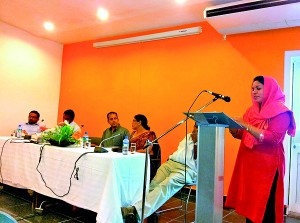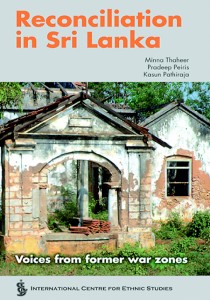Sunday Times 2
Reconciliation redefined
The war is over. Sri Lanka’s territorial integrity has been restored. The writ of the President, who exercises the executive power of the people, runs all over Sri Lanka. But are we one country? Geographically, yes. But we are not one people yet, although more than four years have lapsed since the separatist Liberation Tigers of Tamil Eelam (LTTE) which administered a state within a state was militarily defeated.

Minna Thaheer, one of the authors introducing the book at the launch held on Wednesday at the International Centre for Ethnic Studies
The Sri Lankan identity exists on paper, but the sense of alienation that led to the separatist war still prevails in some form or the other. The Government in a bid to defeat the separatist ideology has launched a reconciliation programme which largely manifests itself in its rapid development process – a process driven by the belief that economic prosperity will bind the north and the south through interdependence.
But this reconciliation process brings in its wake untold hardship, breeds suspicion, divides people, shatters communities, cultures and families, according to a book that was launched this week in Colombo.
The authors of the book, three young researchers, see that the road to reconciliation is being paved with many a pitfall. This is largely because the state-led reconciliation process has a top-down approach.
Highlighting that there is little accommodation of the views or aspirations of the affected people in development or reconciliation, the three researchers — Minna Thaheer, Pradeep Peiris and Kasun Pathiraja — discover many contradictions and ironies that the state-led reconciliation process has created. On the one hand, it assures security but on the other, it contributes to insecurity. It builds trust while sowing the seeds of mistrust. It brings about progress in one area but causes regression in other areas.
In their book, “Reconciliation in Sri Lanka: Voices from Former War Zones,” the authors try to find the answer to what reconciliation means in Sri Lanka’s post-war context. What it means to the Government and to the people, especially the people of the former war zones.
The authors agree that defining reconciliation is a problem. The government has a development-oriented definition for reconciliation. This evidently sidelines the people’s interest. So the authors get the term defined by the affected people: A bold step, indeed.
 The discourse on the definition of reconciliation in Chapter Two will appeal to the fair-minded as it stresses the need for truth, forgiveness, justice and peace — a reconciliation process similar to what took place in South Africa. The discourse implies national level reconciliation with truth and reconciliation efforts may not necessarily and automatically transform communities or their values. Yet they can create conditions for better relationships. In short, more than the forms of devolution or decentralisation, what is of greater importance is the creation of a just society where peace with justice is established. I agree with the authors that reconciliation is a two way process, but sadly there is very little the Government has done to educate the Sinhala people on the need for reconciliation.
The discourse on the definition of reconciliation in Chapter Two will appeal to the fair-minded as it stresses the need for truth, forgiveness, justice and peace — a reconciliation process similar to what took place in South Africa. The discourse implies national level reconciliation with truth and reconciliation efforts may not necessarily and automatically transform communities or their values. Yet they can create conditions for better relationships. In short, more than the forms of devolution or decentralisation, what is of greater importance is the creation of a just society where peace with justice is established. I agree with the authors that reconciliation is a two way process, but sadly there is very little the Government has done to educate the Sinhala people on the need for reconciliation.
Liberated or conquered?
The book is not based on arm-chair research. The authors go to both the interior and the periphery of the former war zones where life begins under the Government’s watchful eye and talk to the people while listening to their grievances. Their field research included interviews with some 600 people — the Sinhalese, the Tamils and the Muslims in the North and the East — and their findings bring out the home truth which the powers that be have chosen not to see or attach no importance. In addition, the authors have perused more than 150 research papers, newspaper articles and websites.
The authors ask the question: Do the people of the former war zones feel liberated or conquered? They do not jump to any conclusion but the reader finds the answer between the lines. The book brings out, among other ground realities, the optimism of the Sinhala community in the war zones and varying degrees of pessimism expressed by the Tamils and the Muslims in the areas.
I welcome the timely effort in getting the views of the affected people when the question of devolution has once again taken centre stage. If the authorities are serious about uplifting the living standards of the affected people and if they believe that development does not mean only economic progress but also means political, cultural and social development — a holistic one — then they should read this book published by the International Centre for Ethnic Studies.
The main thematic thrust of the book is to show that reconciliation needs to move beyond rhetoric and touch the lives of people who seek some of the main prerequisites of reconciliation — security, truth and justice, factors that will restore their lost dignity and erase the feeling of being lesser citizens.
Rule of Law, another area where the Government efforts and commitment have been wanting, also has a place in the reconciliation process. In Chapter Six, the authors indicate that respect for the rule of law makes it easier to achieve reconciliation in war-affected communities.
Achieving a just society is the goal of reconciliation, the authors insist as they try to promote participatory development. Throughout the book, there are useful hints for the Government to realise its mistakes, reset its reconciliation process and make it for the people, of the people and by the people. If there is no people participation or respect for their views, the reconciliation process, in the words of the authors, would be a case of ‘one step forward and two steps back’. Among the majority of the war-affected Tamil people, there is much aversion for politics and politicians, including mainstream Tamil politicians. This is because, as the book indicates, the rights of the people to development have been made political at the crudest level in terms of petty party politics.
They trust the President
The authors say that a majority of the people in the former war zones — some of whom had no contact with the State during the war — appreciate the development projects and they trust the President more than all other government politicians and institutions. Yet the State-society relationship in the north is much weaker than that of the south. The people feel a sense of alienation due to language barriers and the presence of security officers in civilian affairs such as community meetings. Although some appreciate the military’s role in community service, others see dangerous consequences, especially in areas where a first time visitor will ask “Where have all the men gone.”
“Despite benefiting from the post-war development programmes, the process continues to breed suspicion. In areas where the military provides security the traditional, sexual and cultural mores of these communities — cleansed of men — have been disrupted and women are sometimes forced into exploitative sexual relations to secure personal, familial and economic security,” the book says.
The book emits a warning signal that ‘the war is over but the conflict is not’. The research reveals that economic upliftment and modernisation alone cannot reconcile communities while linguistic and ethnic disparities remain unresolved. It also reveals that most of the Tamils in the former war zones have little faith in a political solution coming from the Sinhala-dominant government. A Tamil farmer says, “If they are not willing to give us the freedom to sing the national anthem in our own language there is no point in even thinking that they would give us any other powers that they promise.”
The difficulties the displaced Muslim community face and the problems regarding their resettlement and their socio-economic conditions are also dealt in some detail in the book.
The 178-page book written in lucid language bereft of the usual NGO jargon gives vital ethnicity-based statistics and generalisations with bar charts. I wish they had been in colour as the black and white adds some inconvenience to the reader. The book makes interesting reading for those who seek to feel the pulse of the people in the former war zones, despite the usual drawbacks associated with interview-based social research, especially questions over generalisation and how free or genuine the people were when they responded to the survey.
| Book facts
Reconciliation in Sri Lanka: Voices from Former War Zones |
Follow @timesonlinelk
comments powered by Disqus

